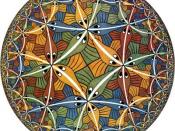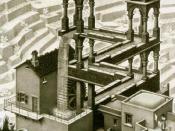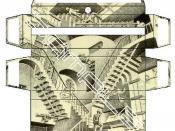Maurits Cornelis Escher, who was born in Leeuwarden, Holland in 1898, created unique and fascinating works of art that explore and exhibit a wide range of mathematical ideas.
While he was still in school his family planned for him to follow his father's career of architecture, but poor grades and an aptitude for drawing and design eventually led him to a career in the graphic arts. Among his greatest admirers were mathematicians, who recognized in his work an extraordinary visualization of mathematical principles. This was the more remarkable in that Escher had no formal mathematics training beyond secondary school.
Escher used logic of space, by the "logic" of space I mean those spatial relations among physical objects which are necessary, and which when violated result in visual paradoxes, sometimes called optical illusions. All artists are concerned with the logic of space, and many have explored its rules quite deliberately, Picasso for instance.
Escher understood that the geometry of space determines its logic, and likewise the logic of space often determines its geometry. One of the features of the logic of space which he often applied is the play of light and shadow on inwardly and outwardly objects. In the picture Cube with Ribbons, the bumps on the bands are our visual clue to how they are intertwined with the cube. However, if we are to believe our eyes, then we cannot believe the ribbons.
Another of Escher's chief concerns was with perspective. In any perspective drawing, vanishing points are chosen which represent for the eye the point(s) at infinity. It was the study of perspective and "points at infinity" by Alberti, Desargues, and others during the renaissance that led directly to the modern field of projective geometry.
By introducing unusual vanishing points and forcing elements of a composition to...


